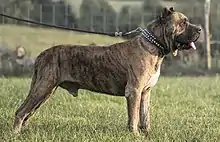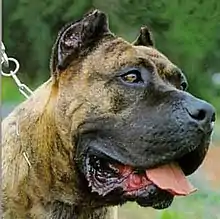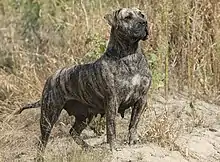Presa Canario
The Presa Canario is a Spanish breed of large dog of mastiff or catch dog type. It was traditionally used for working livestock. It was formerly known as the Dogo Canario.
| Presa Canario | |||||||||||||||||
|---|---|---|---|---|---|---|---|---|---|---|---|---|---|---|---|---|---|
 | |||||||||||||||||
| Other names |
| ||||||||||||||||
| Origin | Canary Islands, Spain | ||||||||||||||||
| |||||||||||||||||
| |||||||||||||||||
| Dog (domestic dog) | |||||||||||||||||
History
In 1991 the Presa Canario was included in a list of national symbols of the Canary Islands as a symbol of the island of Gran Canaria.[1]:2610 It was officially recognised by the Spanish national government in 2001.[2]
The breed was provisionally accepted by the Federation Cynologique Internationale in 2001 under the name Dogo Canario;[3] it was fully accepted in 2011.[4] In December 2018, at the request of the Real Sociedad Canina de España, the name was changed to Presa Canario.[5]
Characteristics


The Presa Canario is a large dog with a heavy muscular body.[6] Dogs stand 60–66 cm at the withers and weigh some 50–65 kg; bitches stand about 56–62 cm and weigh approximately 10 kg less.[7]
The head is broad, massive, square, and powerful brachycephalic shape. Proper head and good expression are part of the breed standard, and are manifest in the best breed specimens. The ears are normally cropped, both to create a more formidable expression and to prevent damage while working with cattle. If cropped, the ears stand erect. In countries where ear-cropping is banned, the ears are close fitting to the head; they hang down and should be pendant or "rose" shaped. The upper lip is pendulous, although not excessively. Seen from the front, the upper and lower lips come together to form an inverted V. The flews are slightly divergent. The inside of the lips is a dark colour.[7]
The breed is also characterized by a sloping topline (with the rear being slightly higher than the shoulders). Another characteristic of the breed is the shape of the paws (cat foot) and the catlike movement of the animal. The body is mesomorphic, that is, slightly longer than the dog is tall, contributing to the feline movement.
Temperament
Presas require early socialization and obedience training.[8]
In County Galway, Ireland in 2017, a woman was killed when she entered her son's home and was attacked by three of these dogs, which were being used by the son as guard dogs.[9]
Legal restrictions on ownership
Importation and sale of the breed is prohibited in Australia[10] and New Zealand.[11]
Use
In addition to the traditional role of cattle dog, the Presa Canario has been used for dog fighting.[12][13][14] Until the 1950s it remained a common practice in all of the islands.[15] [16]
Footnotes
| Wikimedia Commons has media related to Dogo Canario. |
- Lorenzo Olarte Cullen (30 April 1991). Disposiciones Generales - Presidencia del Gobierno: 577 - LEY 7/1991, de 30 de abril, de símbolos de la naturaleza para las Islas Canarias (in Spanish). Boletín Oficial de Canarias. 61 (10 May 1991): 2610–2611.
- [Ministerio de Agricultura, Pesca y Alimentación] (25 May 2001). Real Decreto 558/2001, de 25 de mayo, por el que se regula el reconocimiento oficial de las organizaciones o asociaciones de criadores de perros de raza pura (in Spanish). Boletín Oficial del Estado 142 (14 June 2001): 21156–21182. Reference: BOE-A-2001-11347.
- Nomenclature des races: Races acceptées provisoirement. Fédération Cynologique Internationale. Archived 6 February 2002.
- FCI breeds nomenclature: Presa Canario. Fédération Cynologique Internationale. Accessed February 2021.
- Y. De Clercq (6 December 2018). New name for Dogo Canario (346). Fédération Cynologique Internationale. Accessed February 2021.
- Santana, Clemente Reyes. "El Perro de Presa Canario". ElPresa.com. Retrieved 16 November 2008.
- Brígida Nestler, Miguel Ángel Martínez (2018). FCI-Standard N° 346 Presa Canario. Fédération Cynologique Internationale. Accessed February 2021.
- "Perro de Presa Canario FAQ". United Perro de Presa Canario Club. Archived from the original on 28 September 2007. Retrieved 19 August 2007.
- "'Loving and caring' grandmother attacked by her son's dogs died of 'massive' injuries, inquest hears". Independent.ie.
- "Customs (Prohibited Imports) Regulation 1956". Retrieved 2 September 2010.
- "Another dog added to banned list". Archived from the original on 13 June 2011. Retrieved 2 September 2010.
- Brough, Graham (7 February 2006). "EXCLUSIVE: COP ALERT OVER 'PIT BULL ON STEROIDS'". mirror. Retrieved 7 February 2019.
- "Killer Dog Sparks Interest in Rare Breed". ABC News. 7 January 2006. Retrieved 29 August 2018.
- Gracia, Manuel Curto (20 November 2012). Perro De Presa Canario: Special Rare-Breed Edition : A Comprehensive Owner's Guide. i5 Publishing. ISBN 9781621870753. Retrieved 29 August 2018 – via Google Books.
- "Canary Island dog incident will provoke anti-dog backlash". old.post-gazette.com. Archived from the original on 29 August 2018. Retrieved 29 August 2018.
- "Presa Demand Grows for All Wrong Reasons / Dogs wanted for killing, fighting". San Francisco Gate. 7 February 2001. Retrieved 29 August 2018.